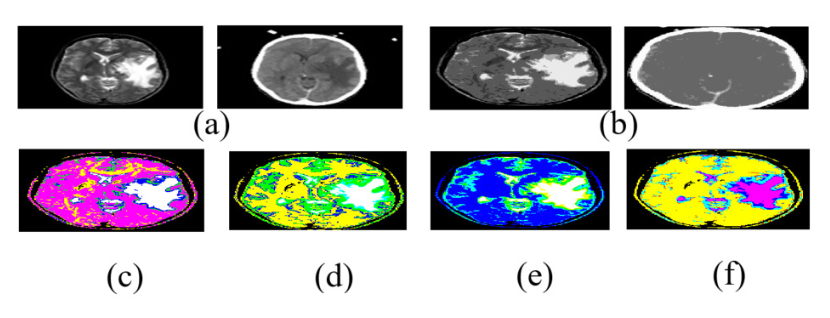Brain Tumor Detection Through Modified Optimization Algorithm by Region-based Image Fusion
Main Article Content
Abstract
This article is about the fusion of Brain images which are having different features. This article addresses the problems raised in pixel-level image fusion,such as blurring and artifacts caused by the unwanted addition of noise components in fused images. We extracted the regions of the brain image with the proposed tested optimal thresholding-based segmentation by optimizing thresholds with the proposed Sine function adapted improved Whale Optimization Algorithm (SiWOA) algorithm. We named the proposed fusion as SiWOA-FUSION. These optimal segmented regions and discrete wavelet coefficients of images are fused based on interval type - 2 fuzzy rules. Finally, combined image visual quality is optimized with SiWOA by assuming the amount of the correlation of differences (ACD) as an objective function. Experiments are tested on standard benchmark databases and proved better than existing methods.
Article Details

This work is licensed under a Creative Commons Attribution-NonCommercial-NoDerivatives 4.0 International License.
References
G. Vivone et al., “A Critical Comparison Among Pansharpening Algorithms,” in IEEE Transactions on Geoscience and Remote Sensing, vol. 53, no. 5, pp. 2565-2586, May 2015.
A. P. James and B. V. Dasarathy, “Medical image fusion: A survey of state of the art,” Information Fusion, vol. 19, pp. 4-19, Sep. 2014.
Y. Liu, L. Wang, J. Cheng, C. Li and X. Chen, “Multi-focus image fusion: A Survey of state of the art,” Information Fusion, 64, vol. 71-91, Dec. 2020.
C. Hessel and J. -M. Morel, “An extended exposure fusion and its application to single image contrast enhancement,” in The IEEE Winter Conference on Applications of Computer Vision, pp. 137-146, 2020.
T. Li and Y. Wang, “Biological image fusion using NSCT based variable-weight method,” Information Fusion, vol. 12, no. 2, pp. 85-92, 2011.
S. Maqsood and U. Javed, “Multi-modal medical image fusion based on two-scale image decomposition and sparse representation,” Biomedical Signal Processing and Control, vol. 57, 101810, Mar. 2020.
Q. Zhang, Y. Liu, R. S. Blum, J. Han and D. Tao, “Sparse representation based multi-sensor image fusion for multi-focus and multi-modality images: A review,” Information Fusion, vol. 40, pp. 57-75, Mar. 2018.
K. Wang, G. Qi, Z. Zhu and Y. Chai, “A novel geometric dictionary construction approach for sparse representation based image fusion,” Entropy, vol. 19, no.7:306, 2017.
H. R. Shahdoosti and H. Ghassemian, “Combining the spectral PCA and spatial PCA fusion methods by an optimal filter,” Information Fusion, vol. 27, pp. 150-160, Jan .2016.
Z. Zhu, H. Yin, Y. Chai, Y. Li and G. Qi, “A novel multi-modality image fusion method based on image decomposition and sparse representation,” Information Sciences, vol. 432, pp. 516- 529, Mar 2018.
M. K. Abd Ghani, M. A. Mohammed, N. Arunkumar, S. A. Mostafa, D. A. Ibrahim, M. K. Abdullah, and M. A. Burhanuddin, “Decisionlevel fusion scheme for nasopharyngeal carcinoma identification using machine learning techniques,” Neural Computing and Applications, vol 32 no.3, pp. 625-638, 2020.
S. Liu et al., “Multi-Focus Color Image Fusion Algorithm Based on Super-Resolution Reconstruction and Focused Area Detection,” in IEEE Access, vol. 8, pp. 90760-90778, 2020.
M. Bitenc, D. S. Kieffer and K. Khoshelham, “Evaluation of Wavelet Denoising Methods for Small-Scale Joint Roughness Estimation Using Terrestrial Laser Scanning,” ISPRS Annals of Photogrammetry, Remote Sensing & Spatial Information Sciences, vol. 2, pp.81-88, 2015.
K. Chiranjeevi and U. Jena, “SAR image compression using adaptive differential evolution and pattern search based K-means vector quantization,” Image Analysis & Stereology, vol. 37, no. 1, pp. 35-54, 2018.
S. Mirjalili and A. Lewis, “The whale optimization algorithm,” Advances in Engineering Software, vol. 95, pp. 51-67, May 2016.
V. Aslantas, E. Bendes, R. Kurban and A. N. Toprak, “New optimised region-based multiscale image fusion method for thermal and visible images,” IET Image Processing, vol. 8, no. 5, pp. 289-299, May 2014.
M. S. R. Naidu, P. R. Kumar and K. Chiran- jeevi, “Shannon and fuzzy entropy based evolutionary image thresholding for image segmentation,” Alexandria Engineering Journal, vol 57, no.3, pp. 1643-1655, Sep 2018.
J. M. Mendel and R. I. B. John, “Type-2 fuzzy sets made simple,” in IEEE Transactions on Fuzzy Systems, vol. 10, no. 2, pp. 117-127, April 2002.
Qilian Liang and J. M. Mendel, “Interval type-2 fuzzy logic systems: theory and design,” in IEEE Transactions on Fuzzy Systems, vol. 8, no. 5, pp. 535-550, Oct. 2000.
A. K. Shukla, S. K. Banshal, T. Seth, A. Basu, R. John and P. K. Muhuri, “A Bibliometric Overview of the Field of Type-2 Fuzzy Sets and Systems [Discussion Forum],” in IEEE Computational Intelligence Magazine, vol. 15, no. 1, pp. 89-98, Feb. 2020.
Y. Yang, Y. Que, S. Huang and P. Lin, “Multimodal Sensor Medical Image Fusion Based on Type-2 Fuzzy Logic in NSCT Domain,” in IEEE Sensors Journal, vol. 16, no. 10, pp. 3735-3745, May 15, 2016.


